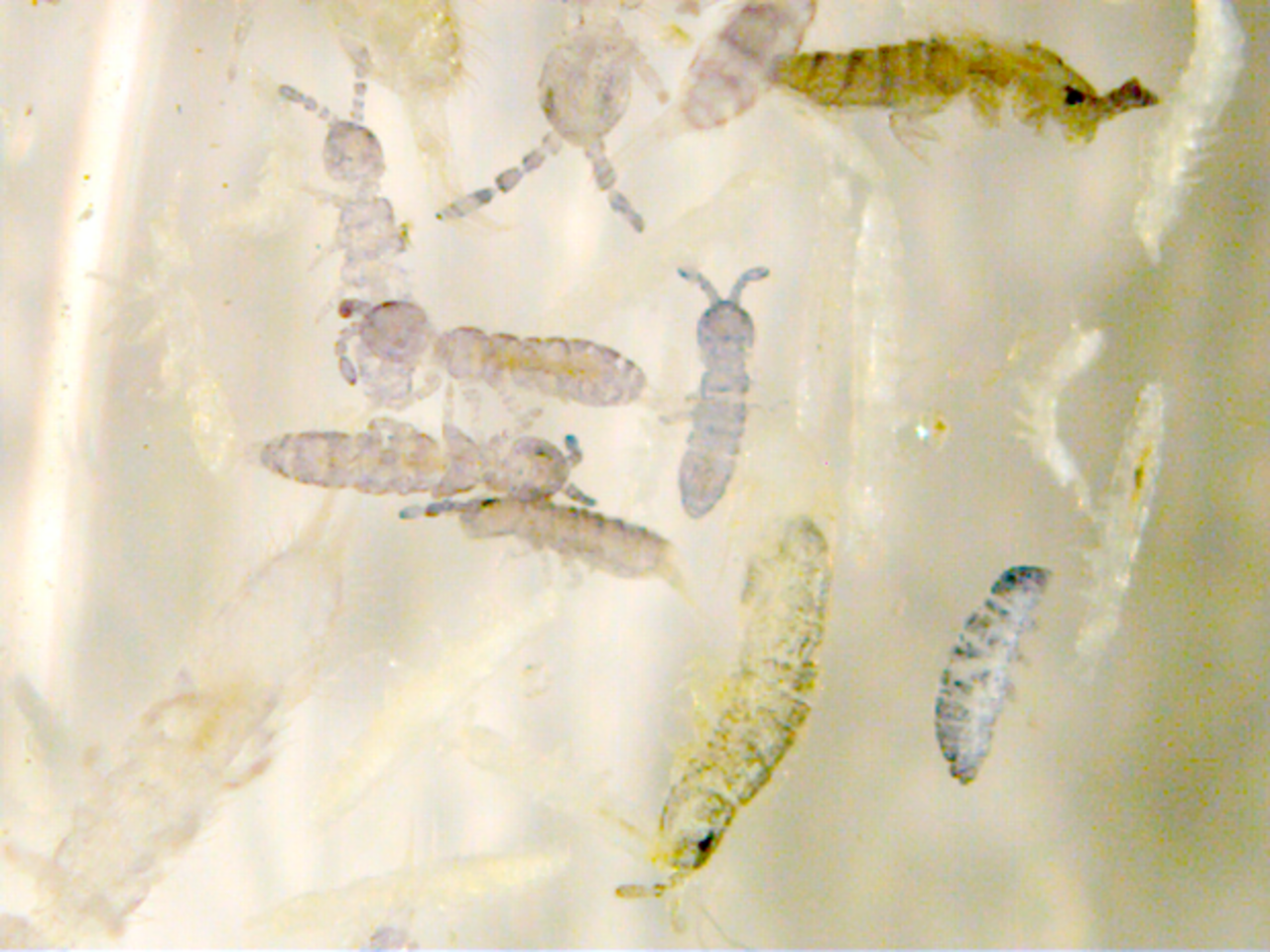Project
Soil fauna diversity in agroecosystems

Monitoring and assessment of soil fauna diversity in agroecosystems
Agricultural management like soil tillage, cropping sequence, plant pest management, fertilisation etc. controls biodiversity in agroecosystems. Presence and abundance of different species of soil fauna affect soil functions considerably.
Background and Objective
Keystone species of the microfauna (e.g. nematodes), mesofauna (e.g. enchytraeids, collembolans) and the macrofauna (e.g. earthworms) are involved in many important soil processes. The identification of keystone species in soil and assessment of their interactions in soil under the specific conditions of agricultural management are priority objectives of research to gain scientific knowledge for maintaining our resources of agricultural production.
Our aims are
(i) to identify and to assess soil fauna diversity in agroecosystems;
(ii) to find solutions for the protection and promotion of soil fauna diversity in agroecosystems.
Target Group
We disseminate our scientific output to the science community, to farmers and advisors as well as policy makers and the wider public.
Approach
Based on standardised methods according to ISO guidelines, we take sample in agricultural fields under varying management schemes at experimental sites and farms to monitor and assess the diversity of earthworms, collembolans and nematodes in different soils.
Preliminary Results
Our results on the diversity of soil fauna are published in various journals, book chapters and brochures covering the following subjects: soil tillage, soil compaction, effect of greenhouse gases, organic farming.
Thünen-Contact

Duration
Permanent task 8.2003 - 12.2028
More Information
Project status:
ongoing
Publications
- 0
Jacobs A, Schrader S, Babin D, Beylich A, Brunotte J, Dauber J, Emmerling C, Engell I, Flessa H, Hallmann J, Hommel B, Klages S, Lehmhus J, Meyer M, Meyer-Wolfarth F, Potthoff M, Runge T, Schulz-Kesting K, Tebbe CC, Capelle C van, et al (2022) Lebendige Böden - fruchtbare Böden. Bonn: Bundesanstalt für Landwirtschaft und Ernährung, 48 p
- 1
Horn R, Schrader S, Mordhorst A, Fleige H, Schroeder R (2022) Soil health and biodiversity: Interactions with physical processes and functions [online]. In: Reyes-Sánchez LB, Horn R, Costantini EAC (eds) Sustainable soil management as a key to preserve soil biodiversity and stop its degradation. Vienna: International Union of Soil Sciences (IUSS), pp 314-330, zu finden in <https://www.iuss.org/media/iuss_sustainable_soil_management_as_a_key_to_preserving_soil_biodiversity_and_stopping_its_degradation_book.pdf > [zitiert am 27.06.2022]
- 2
Ludwig M, Wilmes P, Schrader S (2018) Measuring soil sustainability via soil resilience. Sci Total Environ 626:1484-1493, DOI:10.1016/j.scitotenv.2017.10.043
- 3
Schorpp Q, Schrader S (2017) Dynamic of nematode communities in energy plant cropping systems. Eur J Soil Biol 78(1):92-101, DOI:10.1016/j.ejsobi.2016.12.002
- 4
Schorpp Q, Müller AL, Schrader S, Dauber J (2016) Agrarökologisches Potential der Durchwachsenen Silphie (Silphium perfoliatum L.) aus Sicht biologischer Vielfalt. J Kulturpfl 68(12):412-422, DOI:10.1399/jfk.2016.12.12
- 5
Schrader S (2016) Bodeninvertebraten sind entscheidende ökologische Leistungsträger. Agrobiodiversität 39:67-80
- 6
Schorpp Q, Schrader S (2016) Earthworm functional groups respond to the perennial energy cropping system of the cup plant (Silphium perfoliatumL.). Biomass Bioenergy 87:61-68, DOI:10.1016/j.biombioe.2016.02.009
- 7
Moos JH, Schrader S, Paulsen HM, Rahmann G (2016) Occasional reduced tillage in organic farming can promote earthworm performance and resource efficiency. Appl Soil Ecol 103:22-30, DOI:10.1016/j.apsoil.2016.01.017
- 8
Hüttl RF, Russell DJ, Sticht C, Schrader S, Weigel H-J, Bens O, Lorenz K, Schneider B, Schneider BU (2012) Auswirkungen auf Bodenökosysteme. In: Mosbrugger V, Brasseur GP, Schaller M, Stribnry B (eds) Klimawandel und Biodiversität : Folgen für Deutschland. Darmstadt: Wiss Buchges, pp 128-163
- 9
Capelle C van, Schrader S, Brunotte J (2012) Bodenbearbeitung steuert phytopathogene Bodenorganismen und ihre Antagonisten. Bodenschutz 4(12):120-126
- 10
Schrader S, Schmelz RM (eds) (2012) Newsletter on Enchytraeidae No. 12 : Proceedings of the 9th International Symposium on Enchytraeidae, 14-16 July 2010, Braunschweig, Germany. Braunschweig: vTI, 102 p, Landbauforsch SH 357
- 11
Capelle C van, Schrader S, Brunotte J (2012) Tillage-induced changes in the functional diversity of soil biota - a review with a focus on German data. Eur J Soil Biol 50:165-181, DOI:10.1016/j.ejsobi.2012.02.005
- 12
Beylich A, Oberholzer H-R, Schrader S, Höper H, Wilke BM (2010) Evaluation of soil compaction effects on soil biota and soil biological processes in soils. Soil Tillage Res 109(2):133-143, DOI:10.1016/j.still.2010.05.010
- 13
Schrader S, Bender J, Weigel H-J (2009) Ozone exposure of field-grown winter wheat affects soil mesofauna in the rhizosphere. Environ Pollut 157(12):3357-3362, DOI:10.1016/j.envpol.2009.06.031
- 14
Sticht C, Schrader S, Giesemann A, Weigel H-J (2009) Sensitivity of nematode feeding types in arable soil to free air CO2 enrichment (FACE) is crop specific. Pedobiologia 52(5):337-349, DOI:10.1016/j.pedobi.2008.12.001
- 15
Sticht C, Schrader S, Giesemann A, Weigel H-J (2008) Atmospheric CO2 enrichment induces life strategy- and species-specific responses of collembolans in the rhizosphere of sugar beet and winter wheat. Soil Biol Biochem 40(6):1432-1445, DOI:10.1016/j.soilbio.2007.12.022
- 16
Schrader S, Anderson T-H, Tebbe CC, Weigel H-J (2007) Monitoring von biologischer Vielfalt in Böden : Notwendigkeit, Ansätze und Fallbeispiele. Agrobiodiversität 27:196-213
- 17
Schrader S, Kiehne J, Anderson T-H, Paulsen HM, Rahmann G (2006) Development of Collembolans after conversion towards organic farming. Asp Appl Biol 79:181-185
- 18
Sticht C, Schrader S, Giesemann A, Weigel H-J (2006) Effects of elevated atmospheric CO2 and N fertilization on abundance, diversity and C-isotopic signature of collembolan communities in arable soil. Appl Soil Ecol 34(2-3):219-229, DOI:10.1016/j.apsoil.2006.01.007

![[Translate to English:] [Translate to English:]](/media/_processed_/4/0/csm_Titel_Ant_Plot_1c3363e3f7.png)
![[Translate to English:] [Translate to English:]](/media/_processed_/b/3/csm_Titel_93px_Ant_Plot_0ef6a20d79.png)
![[Translate to English:] Logo des Bundesministerium für Ernährung und Landwirtschaft](/media/allgemein/logos/BMEL_Logo.svg)